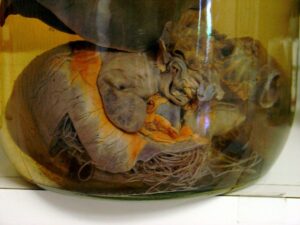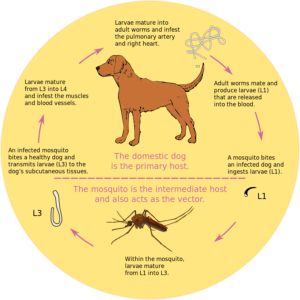 Heartworms are exactly what they sound like. They grow up to fourteen inches long and live in the heart and pulmonary arteries of dogs infected by mosquitoes.
Heartworms are exactly what they sound like. They grow up to fourteen inches long and live in the heart and pulmonary arteries of dogs infected by mosquitoes.
The good news is that conditions must be ideal. Not all mosquitoes can transmit heartworm. Only specific species of mosquitoes can carry heartworm larvae through blood taken by biting an infected animal and then transmitting it to a dog.
Adult female heartworms living in an infected animal give birth to microfilaria, microscopic baby worms. When the mosquito bites an infected animal, it becomes a carrier of microfilaria circulating through the animal’s bloodstream at an earlier stage of development than the larva.
 The mosquito must remain in a warm climate above 57 degrees Fahrenheit for a few weeks after it bites the first dog. During that time, the microfilaria mature into larvae and are ready to infect another dog. If the temperature drops below 57, the mosquito will die.
The mosquito must remain in a warm climate above 57 degrees Fahrenheit for a few weeks after it bites the first dog. During that time, the microfilaria mature into larvae and are ready to infect another dog. If the temperature drops below 57, the mosquito will die.
After the infected mosquito bites another unsuspecting dog, the larva lives in the dog’s skin for approximately three months before traveling into the blood system.
Heartworms mature approximately six months after initially infecting a dog and, once mature, can live in a dog for about six years.

This is very simplified, but hopefully, it will make pet parents aware of the process so they can make an informed decision about protecting their pets against Heartworm disease.
Heartworm disease is life-threatening and affects the lungs, heart, and pulmonary systems. A simple blood test performed by a veterinarian regularly can help monitor whether your dog is infected with heartworms, and it should be performed even if your dog is on a heartworm preventative.

An added note: Humans do NOT catch heartworm disease from their dogs. A human can be infected with heartworms, but only in the same way a dog can, which is from an infected mosquito. However, humans do not make good hosts for heartworms. It is rare in humans, and with treatment, they can make a complete recovery.






